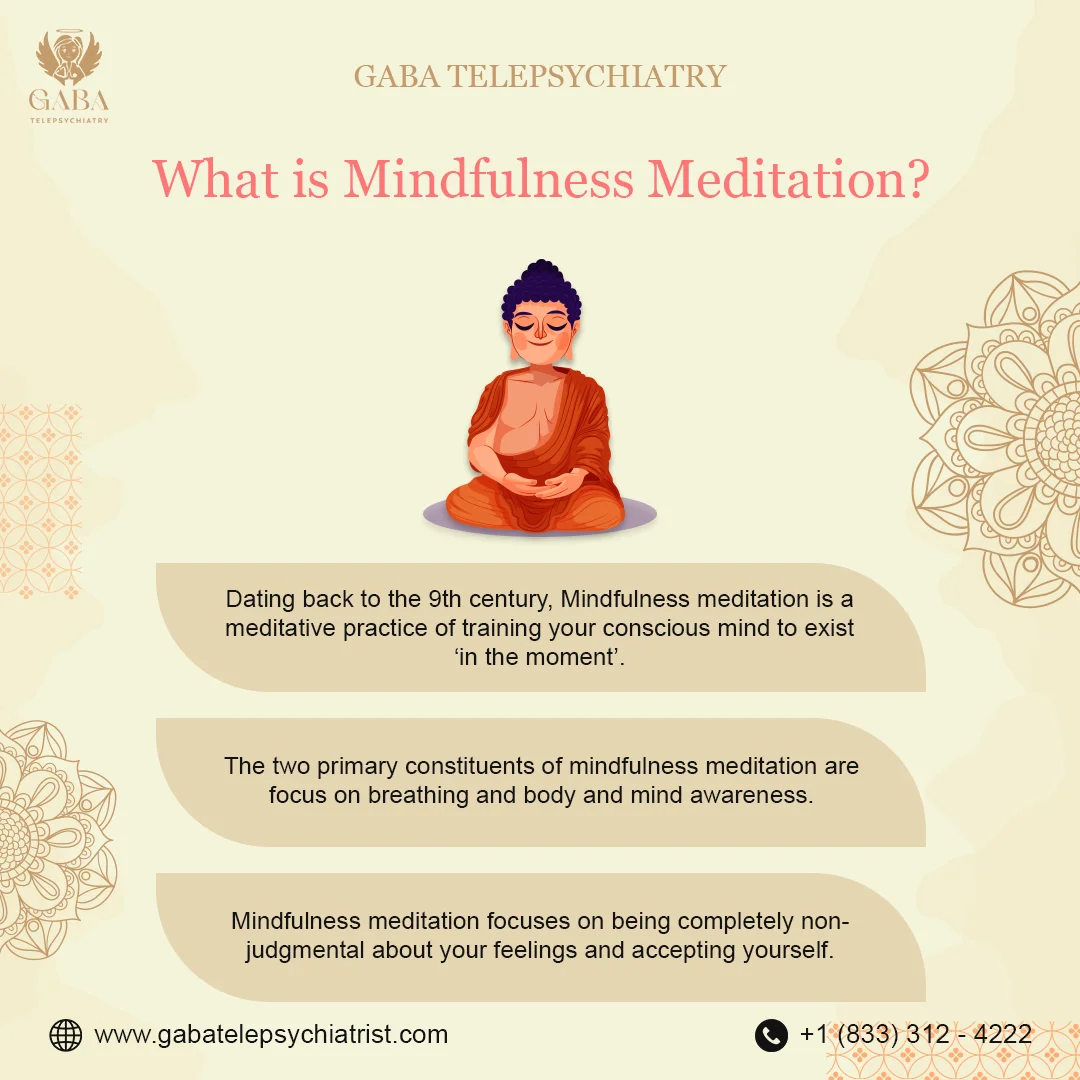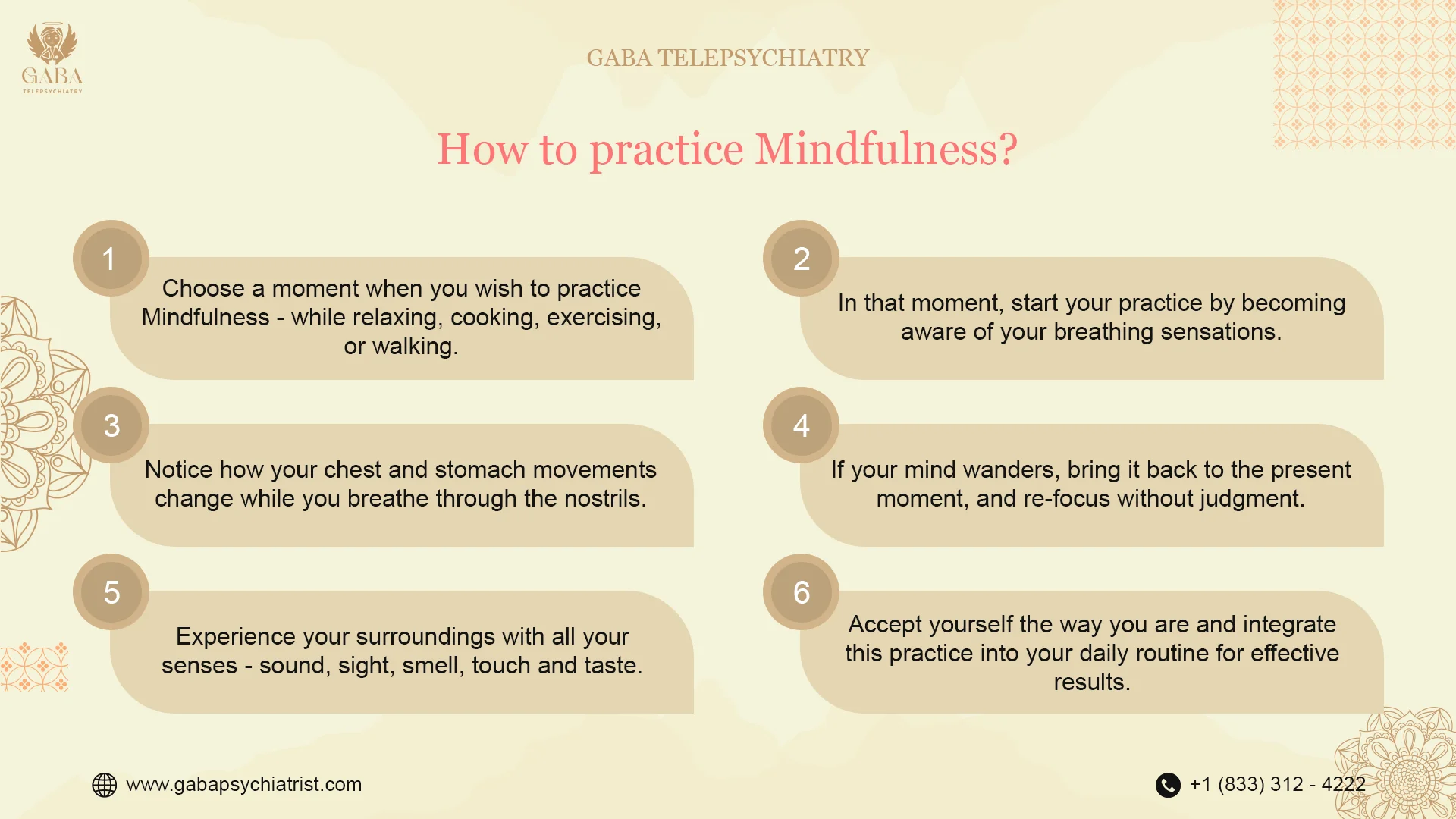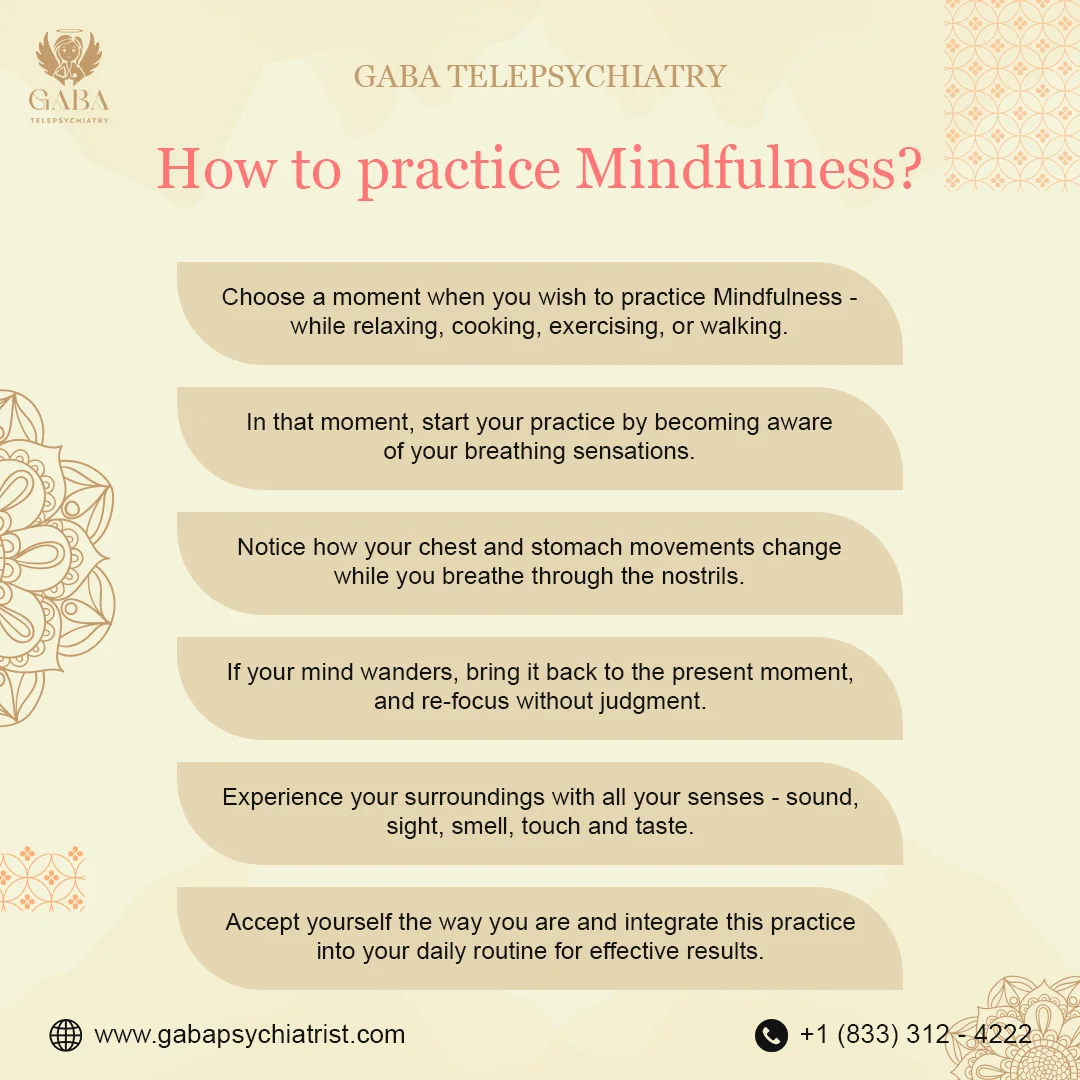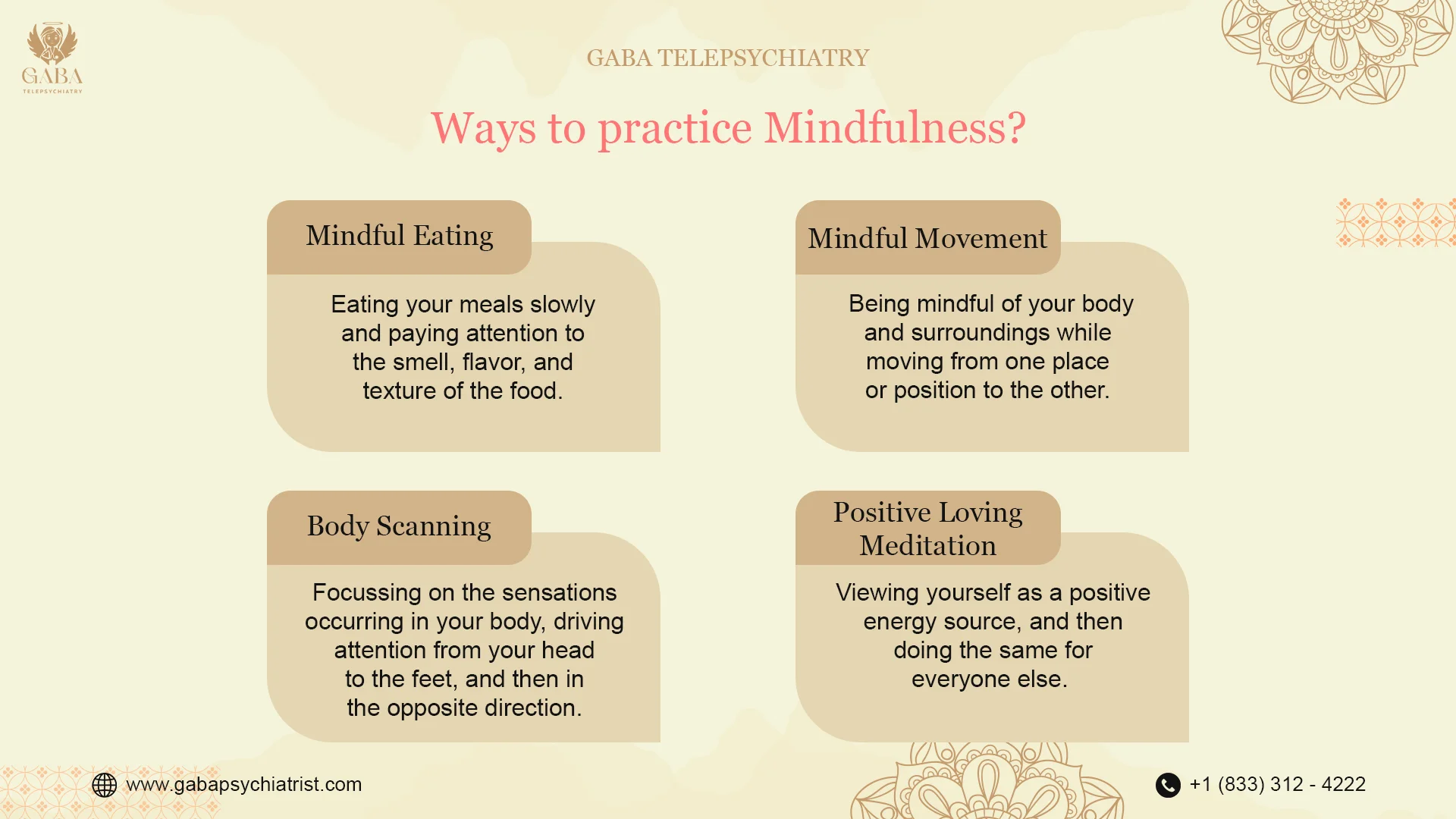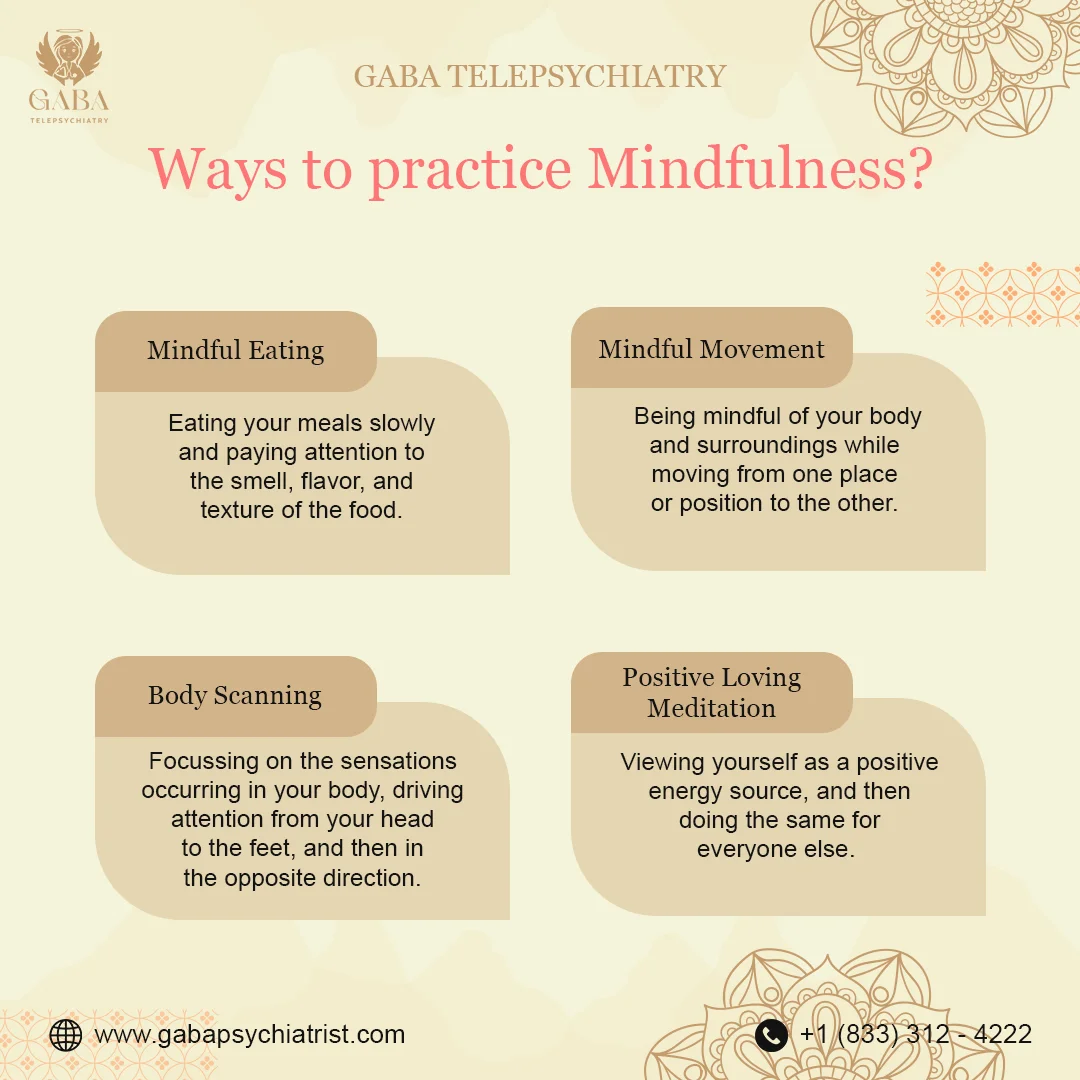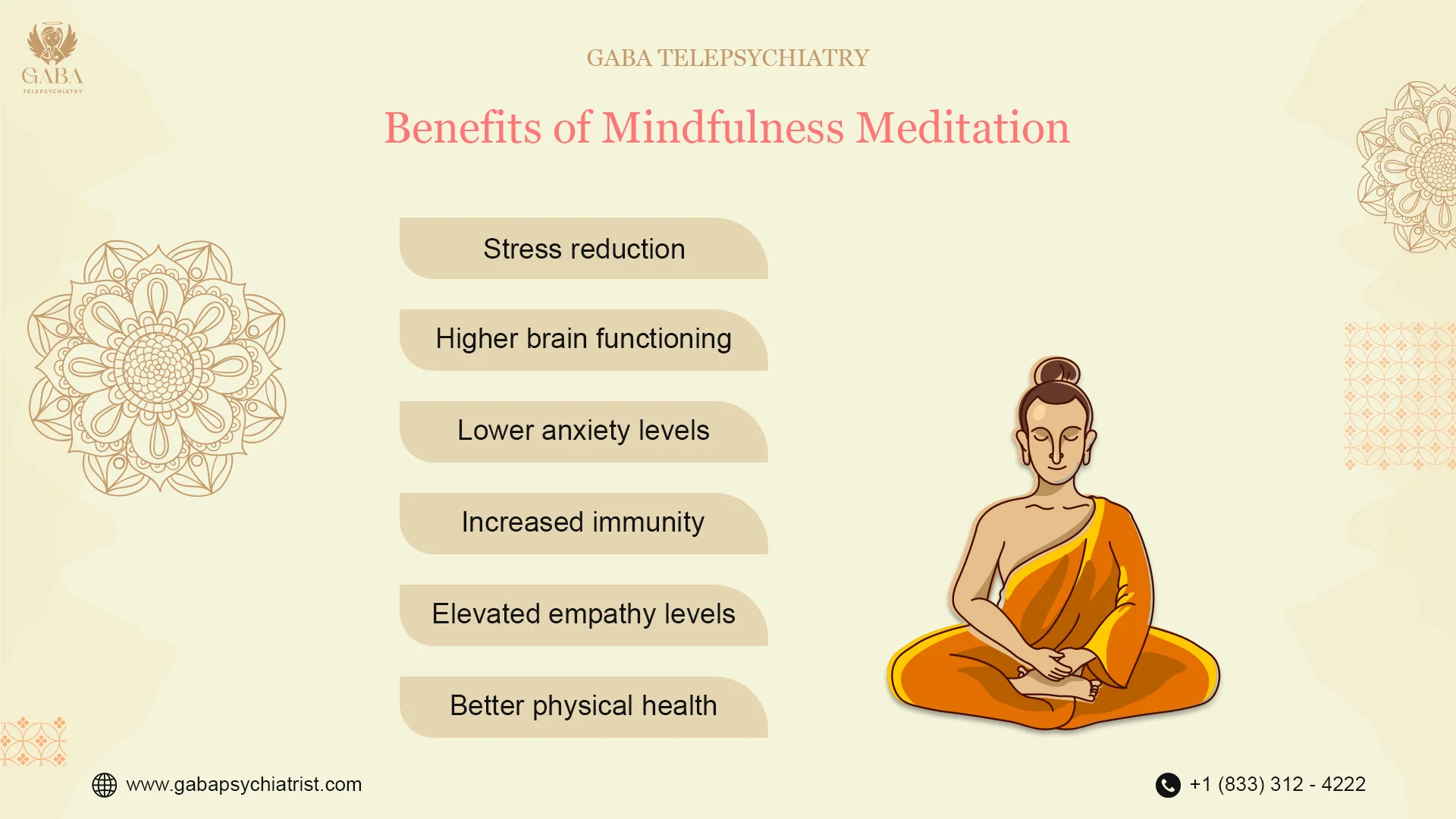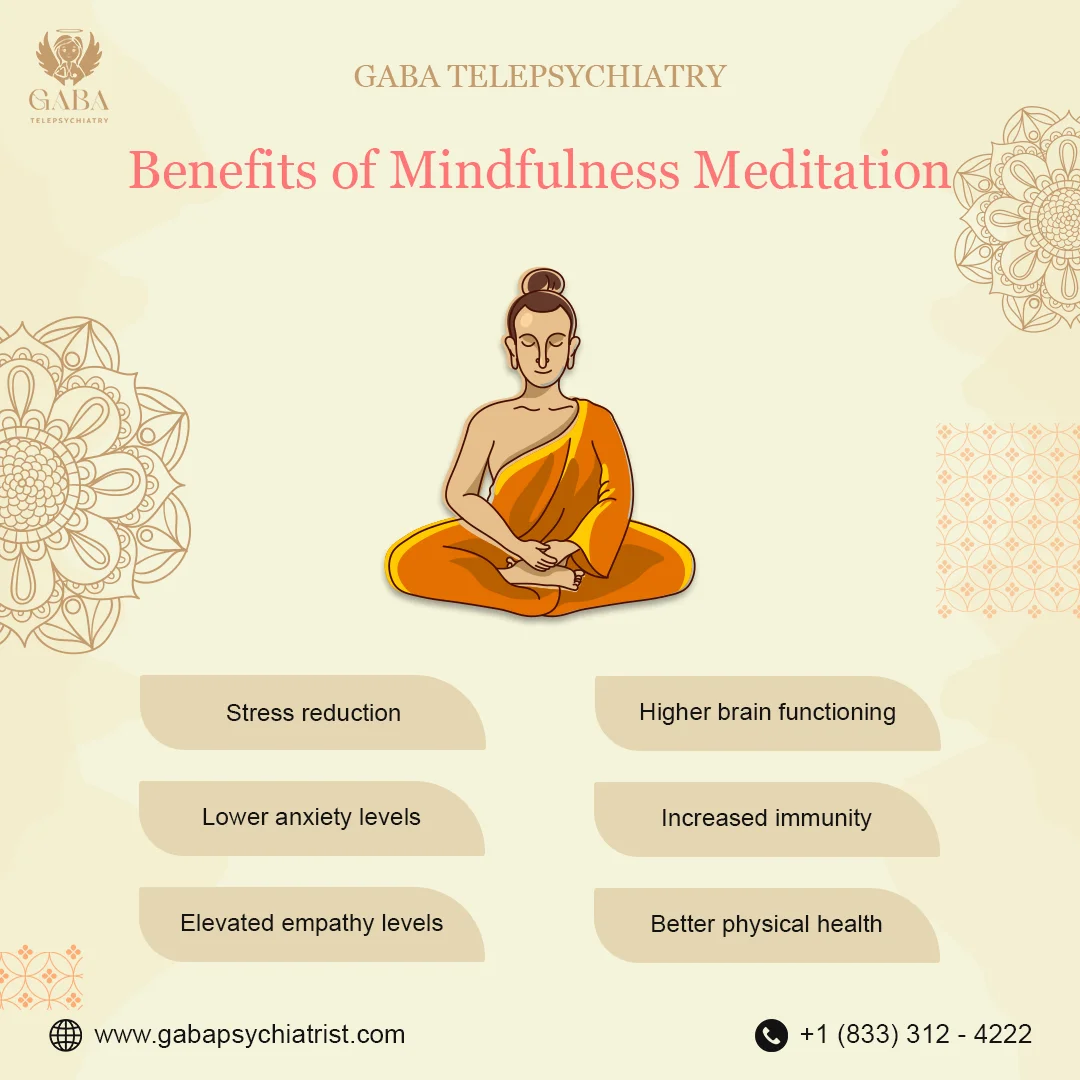Mindfulness meditation is the practice of training your conscious mind to exist ‘in the moment’.
Being ‘in the moment’ means your thoughts are focused on the present, as in the very moment, rather than the past or the future. The principle behind mindfulness meditation is that by focusing on your current breathing, and bodily sensations, you can control your current thoughts and, therefore, your emotions.
Worrying about the future and ruminating about the past are two common causes and symptoms of anxiety and depression. By practicing mindfulness, we both alleviate and prevent symptoms.
Mindfulness meditation focuses on being completely non-judgmental about your feelings. It makes you open to your thoughts and sensations. You can opt for different ways to practice mindfulness meditation. The two primary constituents of this meditation are:
- Focus on breathing, and
- Awareness of your body and mind
This Mindfulness meditation technique is simple yet powerful. Dr. Gundu Reddy, Medical Director at Gaba Telepsychiatry states, “The mind never switches off, even when sleeping, we do not control our dreams. Mindfulness meditation helps the mind switch off and enter the deepest form of sleep, taking a rest from guilt, pain, fear, and rumination. Thus, practicing mindfulness allows the mind to recharge, clear the clutter, focus the thoughts, and possibly connect to the soul”.
Even practicing for five minutes a day, you may notice significant changes in your mental and physical well-being. Mindfulness has been recognized as an approved form of therapy and is growing in popularity, especially in the last ten years.
Originally, this practice dates back to the 9th century. Professor emeritus Jon Kabat-Zinn, founder and former director of the Stress Reduction Clinic, University of Massachusetts Medical Center, was one of the chief contributors to bringing mindfulness meditation to mainstream medicine in the United States. He helped demonstrate how this practice can bring enormous positive changes in behaviors, attitudes, and health.
Kabat-Zinn spent several years learning about the philosophical tenets of Buddhism. He adopted the Buddhist teachings and, in 1979, devised a program called ‘Mindfulness-Based Stress Reduction’ or ‘MSBR.’ Then, in 1990, his publication, ‘Full Catastrophe Living’, attracted global attention. Since then, awareness about mindfulness has continued to evolve.
Today, mindfulness is being taught in schools, sports teams, prisons, and army bases.
What is Mindfulness?
Ask yourself – Am I mindful? Or is my mind full? – and you will probably understand what mindfulness means.
Mindfulness is the state of being in the present, having the awareness of your thoughts and feelings, and rooting yourself in your body. You should not be overwhelmed or over-reactive about your surroundings. Just breathe, and let everything be. Bring your focus back to your breathing pattern and don’t judge your mind for wandering away.
Mindfulness can be practiced during meditation or simply while performing daily activities, such as cleaning, cooking, or walking.
Have you ever paused for a moment to feel the small things? Perhaps the cold breeze flowing against your skin, or the beauty of the clouds in the sky? In those moments, you were practicing mindfulness.
Is there a difference between Mindfulness and Meditation?
Mindfulness and meditation are similar terms. Mindfulness is a type of meditative practice. However, mindfulness can be practiced while doing meditation, but meditation can not be practiced without being mindful.
It is common to struggle with racing thoughts when the mind wanders here and there, in the past and the future. The ‘present’ is the only place where it does not want to be. And sometimes, it is busy drawing scenarios that do not even exist in reality.
Thinking is not bad, as it is what the mind has been wired to do. It constantly hunts new things and ideas to think about. You have achieved mindfulness when you gently train your mind to be where you want it to be and control it rather than letting it control you. That is what true presence feels like.
How to Practice Mindfulness?
Although this technique dates back to the 9th century, it is still as effective and useful in the present. Practicing mindfulness is as simple as focusing on your breath while inhaling and exhaling. It is about reminding yourself about being in the present moment, over and over again.
Put simply, you can practice this technique in almost any context. Whether you are out for a walk, cooking your favorite meal, or doing an exercise routine, every moment brings you the opportunity to embrace the present. Try these steps:
- Start your mindfulness practice by becoming aware of your breathing sensations.
- Notice how your chest and stomach movements change while you breathe through the nostrils; and how it’s cool when you inhale and warm during exhalation.
- It will be common to feel your mind wandering here and there while you practice. Just bring it back to the present moment and start re-focusing on your breath without being judgmental or upset about your performance.
- Practice this over and over again. You can assign a particular part of your day to achieve consistency, or simply try to do it while performing regular chores. Eventually, you will get better and better.
Other Ways to Practice Mindfulness
Apart from mindful breathing, there are other ways that you can integrate into your lifestyle to become even more mindful. These include:
- Mindful eating guides you to eat your meals slowly and pay attention to the smell, flavor, and texture of the food.
- Mindful movement involves being mindful of your body and surroundings while moving from one place or position to the other.
- Body scanning is about focussing on the sensations occurring in your body. You can start by driving your attention from your head to the feet, and then in the opposite direction.
- Positive loving meditation teaches you how to view yourself as a positive energy source, and then do the same for your family and friends. Eventually, you learn how to perceive everyone, even strangers with love and positivity.
What are the Benefits of Mindfulness Meditation?
With the kind of benefits it has for your mental and physical health – it is definite that mindfulness meditation is a healthy habit. In the most challenging circumstances, this technique can help you sustain a strong approach and have control over your reactions.
The following are some important benefits of mindfulness meditation:
Reduces Stress:
Many studies suggest that mindfulness meditation reduces stress levels. Researchers have found that it alters the affective and cognitive processes that underlie many clinical issues. When you start taking care of your stress levels, it will help you achieve higher brain functioning, increase awareness and attention, and lower anxiety levels.
Increases Ability to deal with Illnesses:
As it reduces the symptoms of stress, mindfulness takes you closer to spirituality and makes you less reactive to experience. Various studies performed on cancer patients have demonstrated that practicing this technique instigates a process of positive changes in patients and even their caregivers. Overall, it enhances your ability to deal with chronic illnesses and recover faster.
Improves General Health:
The benefits of mindfulness extend way beyond your mental health. It can also;
- Increase physical activity and inculcate healthy habits
- Improve cardiovascular health and promote healthier body mass index
- Improve eating behaviors and attitudes and support weight management
- Lower blood pressure levels
Induces Empathy and Compassion:
The whole idea behind mindfulness revolves around becoming non-judgmental about your feelings and emotions, and tracing their origins by focusing on the present moment. When you practice this regularly, it becomes easier to be empathetic and compassionate towards yourself, and then towards others. You begin to perceive everyone around you positively. Your control over your mind helps you filter negative perceptions.
Where can you learn how to practice Mindfulness Meditation ?
Learning mindfulness meditation demands you to be in a comfortable and non-judgmental space, with some free time and a relaxed mind. You can personalize your journey to mastering this therapeutic practice – simply by integrating it into your day-to-day life.
But, sometimes, it feels nice to be surrounded by professional mindfulness coaches and like-minded people, who want to take a break from the speediness of life. After all, who doesn’t want to get rid of self-doubt, never-ending worries, and unwanted distractions?
Is it possible to attend a nice meditative session in a quiet place, and even learn how to practice mindfulness perfectly? The answer is Yes!
Are there classes you can take to practice Mindfulness Meditation ?
Yes, there are many meditation and yoga centers all over the US where you can sign up to learn mindfulness meditation. The best part is that some of them are even free of charge!
Whether you are located on the East Coast, West Coast, Southern US, or Midwest, you can join a meditation retreat and start learning mindfulness.
This guide by Book Retreats encapsulates all the best meditation classes and mindfulness meditation centers in every region of the US. You can find all the details of meditation retreats, including the address, contact details, and pricing of their classes in their article.
Are there online courses for Mindfulness Meditation ?
If your home is your haven, or you want to learn mindfulness meditation without the barriers of location, you can also sign up for online classes to make it possible.
These free online mindfulness courses are enlisted by ‘Mindfulness Exercises’, an initiative by Sean Fargo, a mindfulness teacher and guide with fifteen years of experience.
You can also register for online Mindfulness sessions by Stanford Medicine, Inner Space, and many more such providers. A Google search will help you find many free and paid courses that align with your goals and availability.
Are there books on Mindfulness Meditation ?
Books are the most preferred source of information and knowledge for some people. Reading a book might work even better than attending a whole course for them. Below is a list of five books you can read to learn mindfulness meditation at your own pace and convenience.
These are best recommended for beginners, who are just starting with their mindfulness journey and want to understand it step by step.
- Mindfulness for Beginners: A Simple Concise & Complete Guide to Mindfulness Meditation by Jeffrey Holloway
- Real-World Mindfulness for Beginners: Navigate Daily Life One Practice at a Time by Brenda Salgado
- Mindfulness for Beginners: Practical Guide to Mindfulness Meditation & Productive Life: Tips for the 21st Century Human by Martin Lippmann
- Mindfulness: Ultimate Beginners Guide to Embrace Peace, Happiness, and Zen by Eliminating Stress and Anxiety by Kemal Ravakar
- Mindfulness for Beginners: How to Live in the Moment, Stress and Worry Free in a Constant State of Peace and Happiness by Yesenia Chavan
Mindfulness Meditation for Anxiety
Anxiety is your body’s way of responding to stressful situations. It causes a restless mind, continuous negative thoughts, and a struggle to calm down. Even worse, anxiety also has adverse effects on your physical health.
Some of the symptoms of anxiety are:
- Negative intrusive thoughts
- Low attention and concentration
- Confusion and loss of memory
- Sweating and trembling
- Severe headaches and body pain
- Stomach ache
- Distorted reality or paranoia, etc.
When your anxiety symptoms get out of your control, it’s time to seek psychiatric help or try some natural remedies like mindfulness meditation. When going through anxiety, you often lose control of your feelings and get overwhelmed. Mindfulness meditation teaches you to acknowledge and accept your feelings, without being reactive, and peacefully comprehend what your mind is worried about.
When you give your mind the space and permission to accept all the negativity that’s bothering you – whether it is stress, painful memories, or self-doubt – you might be able to delve into the root of these feelings and understand yourself better.
Trying to address anxiety with mindfulness is just another form of self-love, giving yourself the validation you might be seeking from others, and assuring yourself that you’re there to hear yourself out. This will give you the courage and confidence to fight your problems because now you know, you will manage to deal with them.
Mindfulness Meditation for Depression
Depression is more than just feeling sad. It is like constantly experiencing a heavy heart and confused mind, loss of hope and pleasure, and disconnection with yourself. It may interfere with your day-to-day life to an extent that you feel trapped in the middle of wanting to get rid of these feelings, and still not being able to gather enough strength.
Some symptoms that indicate depression include:
- Negative thoughts about self and others
- Excessive guilt about the past and pessimistic thoughts about the future
- Suicidal and self-harm thoughts
- Lack of interest in activities you loved to do
- Loss of self-worth
- Impaired problem-solving
- Loss of appetite
- Sleep disturbance
… and so on.
When you persistently start dwelling on negative thoughts about yourself and your relationships with others, this is called ‘Rumination’. This condition elevates depression and makes it difficult to deal with it.
Mindfulness meditation makes it possible for you to counteract rumination by allowing you to focus on the present moment, and not worry about the past or future. When you start acknowledging your negative thoughts without being judgmental about your mind, it gets easier to face depression and rise above it.
You should start by slowly adopting mindfulness practices in your chores, one step at a time. Try mindful breathing, mindful walking, mindful eating, and practice the habit of letting things go.
This way, you will master the art of being mindful in the simplest moments, and start building your defenses against depression by taking control of your mind.
Always remember – there is no shame in asking for help. If alternative treatments like mindfulness meditation are not working out for you, seek psychiatric help immediately. To overcome the barriers of location and prioritize convenience, it is advisable to see an Online Psychiatrist.
At Gaba Telpsychiatry, we follow the same practices, and guidelines as an in-office visit, achieving the same results and safety standards.
Mindfulness Exercises
The best part about practicing mindfulness is that it easily gets wrapped up with your daily routine, as you can be mindful while doing almost everything.
You can choose your favorite mindfulness exercises and continue to stick to the ones that work out well for you. Try these easy mindfulness exercises and embrace their benefits.
1. The 5-4-3-2-1 Mindfulness Technique
This exercise helps you engage your senses by counting elements around you and feeling your presence in the moment. Try this:
- See: Recognise 5 things around you
- Touch: Feel 4 things that surround you
- Hear: Listen to 3 sounds in your background
- Smell: Detect 2 smells
- Tatse: Identify 1 taste
Take your time to tune into each sense, carefully observe all details, and enjoy everything about this particular moment.
2. Movements and Mindfulness
Integrate mindfulness in the simplest of movements. Pay attention to the sensations in your body, whether you are out for a walk or performing a regular stretching routine.
It is simple – transform your movements into meditation by achieving awareness of your breaths and sensations and being fully present with your body.
3. Eating and Mindfulness
This exercise is about savoring your food, engaging all your senses to recognize the flavor, look, smell, and texture of your meal.
Instead of just gulping up food bite by bite, take the time to appreciate it and be grateful for its presence in your life. Start this for at least one meal a day.
4. Making a Gratitude List
Counting your blessings is a superior act of gratitude. When you do this exercise, it helps you focus on the positive aspects of your life and fosters contentment.
Make it a habit of writing down things, people, and experiences that make you feel grateful, and you will start your journey to ultimate positivity.
5. Listening and Mindfulness
Mindfulness can also be enforced into your conversations with friends, family, colleagues, and strangers. Next time you have a conversation, pay attention to the speaker.
Being a non-judgmental and welcoming listener will strengthen your relationships and help you unlock a whole new degree of mindfulness!
Mindfulness Meditation can help alleviate symptoms of the following psychiatric illnesses, and can be a useful adjunct to conventional treatment:
- Anxiety
- Depression
- Obsessive-Compulsive Disorder
- Social anxiety
- Panic disorder
- Insomnia
- ADHD
- Bipolar disorder
- Postpartum depression
Dr. Gundu Reddy believes that individuals who practice mindfulness meditation tend to need less medication, present with a better response to medication, and demonstrate better long-term social and occupational functioning.
Whether or not you have been diagnosed with a mental illness or are struggling with psychiatric symptoms, mindfulness meditation is a practice that may enrich the quality of your life.


